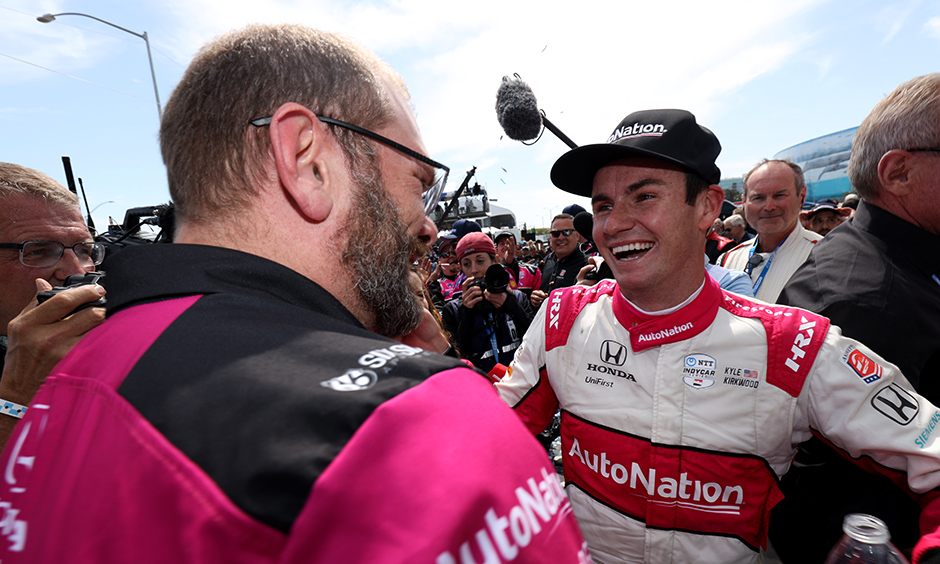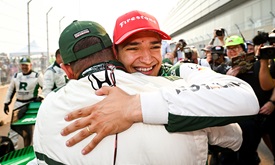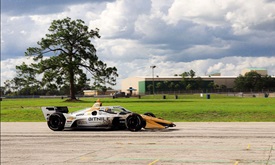The Setup: Road America with Jeremy Milless
JUN 13, 2023
Note: This is a continuing series from INDYCAR.com, with different guests, leading into each race weekend for the NTT INDYCAR SERIES, focusing on various technical challenges of each respective circuit.
The eighth round of the 2023 NTT INDYCAR SERIES season takes place in the land of beers and brats for the Sonsio Grand Prix at Road America presented by AMR.
A field of 27 will run clockwise around the 4.014-mile, 14-turn (six left, eight right) natural terrain road course based in Elkhart Lake, Wisconsin.
There will be two practice sessions and an NTT P1 Award qualifying bout ahead of the race day morning warmup. Coverage for the 55-lap (220.55 miles) race will begin Sunday, 1 p.m. ET (USA, Peacock, INDYCAR Radio Network). The qualifying record is held by Dario Franchitti, who rocketed to a flying lap of 1 minute, 39.866 seconds in 2000.
This week’s featured guest is Jeremy Milless, race engineer for Kyle Kirkwood’s No. 27 AutoNation Honda fielded by Andretti Autosport. Milless worked with former Andretti Autosport driver Alexander Rossi from 2017-22, with the duo capturing one win, three podium finishes and one pole in seven starts at “America’s National Park of Speed.”
Q: What is it like preparing for Road America?
Jeremy Milless: It's not that much different than anywhere else we go to prepare for. It's one of the few tracks that everybody will trim or reduce downforce to get lap time. On road and street courses, that's one of the few changes to other circuits.
Q: From a general point of view, what type of setup does a place like Road America typically favor?
Milless: Well, it's going to be very different this year because they just repaved it. We just went and did a seven-post test after with the new track and it's incredibly smooth, so it's going to be very, very different this year. So, anything we had in the past might not work this year. That's going to be interesting. You might have to be prepared to make really big swings this weekend and kind of trust the simulations are sending you down the right path.
Q: Road America, it’s 4 miles and 14 turns of pure scenic beauty with some obvious tricky spots. Is there any other track on the schedule that you show up with a baseline setup that mirrors anywhere else we go?
Milless: It's pretty different to our others. We run, I would say, a pretty generalized road course setup at most other circuits, and the one at Road America is a little different than the others. It's just because if you look at just how much time you spend in certain corners or like how much time you spend percentage wise in the Carousel (Turns 9-10), it's crazy important. And then it leads onto a really long straightaway, so it tends to lean the setup toward optimizing for certain corners.
Q: With the repave, do you anticipate being able to show up with the same baseline setups that you brought in the past or do you think the new surface will make things dramatically different with ride heights, maybe having to do something different with the dampers, et cetera?
Milless: I think the biggest thing is going to be, looking at the tire test and the cars that tested last week, is going be trying to get tires up to temperature as quickly as we can. At the tire test, they had to do almost a full-length stint to get the tires to come into temperature, which there's not enough time to do that in qualifying. It got much better as the track rubbered in, but I think that's going to be the key this weekend is being able to hit that, being able to hit getting your front and rear tires to come in at the same time.
Q: I didn’t realize it could be that dramatic. I mean, correct me if I’m wrong, but Road America – before the repave – has typically been more temperature sensitive as opposed how it gripped up throughout a race weekend?
Milless: Yeah. It's sensitive to ambient temperature. It's a weird track. It doesn't grip up very quickly because it's so long. So, because it's so long, you're only going to circulate around it 15 times a session. All the cars going around 15 times through one corner, it doesn't put very much grip down very quickly. Whereas if you look at what we did at say Detroit, it was a completely green track, and every session you're going to do 30 laps in that session. So, you get all the cars go through the corners twice as many times as you're going to do at Road America. Yeah, it takes a long time for that place to come in.
Q: I guess the simplest question to follow that up with is do you anticipate the temperature sensitivity of the track to be the main focal point given the fact that temperatures with the tires are going to be tough to raise? Or do you anticipate having it be more dependent on the grip level with the rubber that you're able to lay down?
Milless: Yeah. I would say to be determined because at this point the track is evolving so much that it might just be the standard old Elkhart, and we just have to find the best balance we can for the new circuit. Or we could be struggling with getting tires up to temperature, the optimum operating temperature front and rear at the same time, and that's what we'll be chasing. It's almost, especially since we didn't do the test the last couple days, we're just going to have to show up in the first session and then see what we get and then figure it out overnight. That's where we're at. The tough thing about going into every weekend is you're going to, because the sessions are so short and we're limited so much on tires, get four to five possible setup changes per weekend. That's it. So, you have to be pretty prepared coming in to know what you're going to do and be ready for any scenario. You have a big rundown, ‘OK, if this happens and this happens and...’ Your flow chart, basically, you have to have for every weekend. That's going to be the key is having that flow chart ready and being able to make the right change for what hand you're dealt.
Q: There are a lot of unique aspects when it comes to Road America, what is the trickiest part of the track to set up for?
Milless: Every track is a compromise, right? You have to find your compromise to produce the quickest lap time you can. So, with your setup, we're finding all of our lap time in the high-speed corners, and you just need to keep going down that avenue. Whereas some other cars might be better in the low speeds, not as good as you in the high speed, but they end up turning in almost the same lap time. So, I would say the most important areas are the low- and mid-speed corners at Elkhart, and you just live with what you have in the other corners. That's what I focus on.
Q: And with the repave you feel like…
Milless: It’s ridiculously quick right now.
Q: With that, do you think the track records are going to fall this weekend?
Milless: Yes, 100 percent. Yeah. And the cool thing is it's going to fall from a car that weighs what, 300 pounds more and has 300 horsepower less (than the cars that set the record during the Champ Car era). The cornering speeds are going to be ridiculous compared to Champ Car. That's where all the speed comes from. We're not fast in a straight line, but we go through the corners really fast compared to what they used to.
Q: Back in 2019, you helped provide a car to Alexander Rossi that won by over 28 seconds on the field in one of the more dominant drives in recent memory. When you find a setup that works like that, do you just come back every year with that same setup, at least as a starting point?
Milless: Yeah, but it never works. We went back the next year with the exact same setup and started, and it was not even close because even if Firestone says they're bringing the exact same tire back, they admit that just batch to batch there are small changes. That's everything. It's just figuring out what the tire wants every weekend. Like, we brought the exact same car back that won by 28 seconds, and we were just OK; we were just a top-10 car. We weren't a race-dominating car just because ... and the only thing it had changed is just a different batch of tires.
Q: You spent several seasons with Alexander Rossi during his time at Andretti Autosport and now this year you’ve had to make the adjustment learning what Kyle Kirkwood likes. With that said, in your short time with him, oversteer or understeer, what is more comfortable for Kirkwood?
Milless: I would say he's happy with whatever is quicker (laughs), and we'll try that. Like, there'll be circuits where we go to where the understeering car is quicker, and there'll be circuits where we go to where the looser car is quicker. For instance, at Thermal, when we were testing there, we made a few changes and we just made the car looser and he's like, ‘It's not that much fun to drive, but it's way quicker.’ So, he's just happy to drive whatever produces the lap time and just get on with it, which is nice.
Q: I imagine that is a hell of an adaptable trait to have in the wheelhouse?
Milless: Yeah, it is.
Q: Obviously, Kirkwood is pretty highly regarded within paddock, with many looking at him as a diamond in the rough, so to speak. From what you’ve seen so far, what makes him such a unique talent?
Milless: Yeah, the biggest thing is just the effort he puts in. He just does more at pre-event prep than anybody I've ever seen. It's pretty crazy. Like, going to a new circuit like Detroit, man, he had more notes than I did about what he was going to do. That's the impressive part. It's just he works every single day at it.



















